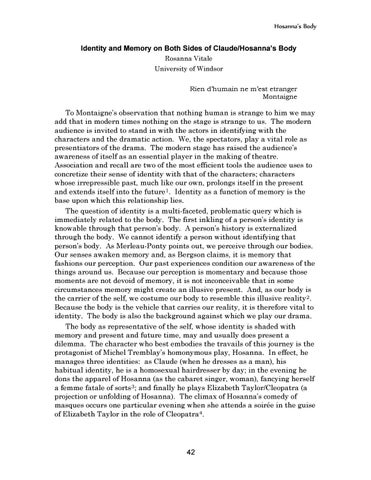Hosanna’s Body Identity and Memory on Both Sides of Claude/Hosanna’s Body Rosanna Vitale University of Windsor Rien d’humain ne m’est etranger Montaigne
To Montaigne’s observation that nothing human is strange to him we may add that in modern times nothing on the stage is strange to us. The modern audience is invited to stand in with the actors in identifying with the characters and the dramatic action. We, the spectators, play a vital role as presentiators of the drama. The modern stage has raised the audience’s awareness of itself as an essential player in the making of theatre. Association and recall are two of the most efficient tools the audience uses to concretize their sense of identity with that of the characters; characters whose irrepressible past, much like our own, prolongs itself in the present and extends itself into the future 1. Identity as a function of memory is the base upon which this relationship lies. The question of identity is a multi-faceted, problematic query which is immediately related to the body. The first inkling of a person’s identity is knowable through that person’s body. A person’s history is externalized through the body. We cannot identify a person without identifying that person’s body. As Merleau-Ponty points out, we perceive through our bodies. Our senses awaken memory and, as Bergson claims, it is memory that fashions our perception. Our past experiences condition our awareness of the things around us. Because our perception is momentary and because those moments are not devoid of memory, it is not inconceivable that in some circumstances memory might create an illusive present. And, as our body is the carrier of the self, we costume our body to resemble this illusive reality 2. Because the body is the vehicle that carries our reality, it is therefore vital to identity. The body is also the background against which we play our drama. The body as representative of the self, whose identity is shaded with memory and present and future time, may and usually does present a dilemma. The character who best embodies the travails of this journey is the protagonist of Michel Tremblay’s homonymous play, Hosanna. In effect, he manages three identities: as Claude (when he dresses as a man), his habitual identity, he is a homosexual hairdresser by day; in the evening he dons the apparel of Hosanna (as the cabaret singer, woman), fancying herself a femme fatale of sorts 3; and finally he plays Elizabeth Taylor/Cleopatra (a projection or unfolding of Hosanna). The climax of Hosanna’s comedy of masques occurs one particular evening when she attends a soirée in the guise of Elizabeth Taylor in the role of Cleopatra 4.
42


